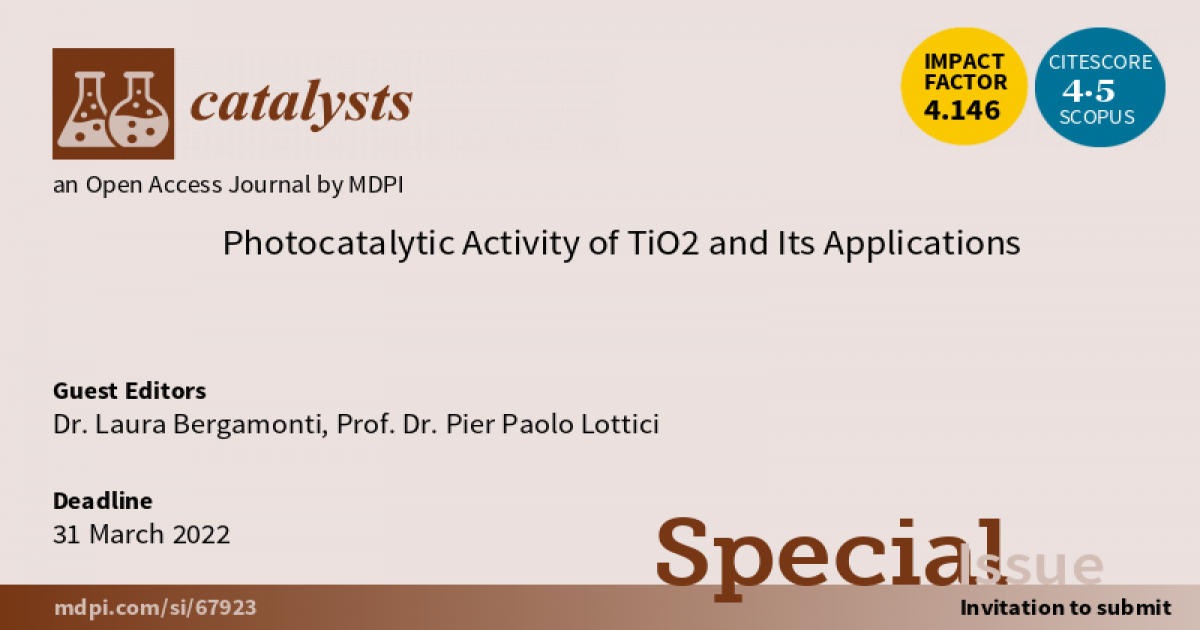Photocatalytic Activity of TiO2 and Its Applications
A special issue of Catalysts (ISSN 2073-4344). This special issue belongs to the section "Photocatalysis".
Deadline for manuscript submissions: closed (31 March 2022) | Viewed by 31107

Special Issue Editors
Interests: cultural heritage materials; paper conservation; spectroscopic characterization; heterogeneous photocatalysis; organic and inorganic pollutant adsorption; environmental chemistry; nanomaterials; crystalline nanocellulose
Special Issues, Collections and Topics in MDPI journals
Special Issue Information
Dear Colleagues,
The increasing pollution due to a wide range of micropollutants, particularly in the aquatic ecosystem, has become a serious issue for its harmful effects on the environment and health. Currently, attention is focused on the use of photocatalysts for the degradation of pollutants by advanced oxidation processes (AOPs). Titanium dioxide (TiO2) is considered the most promising material for the photocatalytic degradation of organic and inorganic pollutants, being highly efficient, non-toxic, and stable under irradiation; therefore, it has been intensively investigated for environmental applications. The most important applications of the photocatalytic activity of titania are in wastewater and air treatments. In recent years, TiO2 has also been investigated for its possible use in cultural heritage conservation science, thanks to its self-cleaning and antipollution properties.
The aim of this Special Issue "Photocatalytic Activity of TiO2 and its Applications" is to present recent progress on the synthesis (with particular interest on metal- and non-metal-doped TiO2 and noble metal-modified TiO2), characterization, and photocatalytic properties of TiO2-based nanostructures. We invite authors to contribute with research papers, reviews, or communications, with special emphasis on visible-light photocatalysis, plasmonic photocatalysis, photodegradation of pharmaceuticals and other emerging contaminants in water, self-cleaning treatments, and conservation of Cultural Heritage.
Dr. Laura Bergamonti
Prof. Dr. Pier Paolo Lottici
Guest Editor
Manuscript Submission Information
Manuscripts should be submitted online at www.mdpi.com by registering and logging in to this website. Once you are registered, click here to go to the submission form. Manuscripts can be submitted until the deadline. All submissions that pass pre-check are peer-reviewed. Accepted papers will be published continuously in the journal (as soon as accepted) and will be listed together on the special issue website. Research articles, review articles as well as short communications are invited. For planned papers, a title and short abstract (about 250 words) can be sent to the Editorial Office for assessment.
Submitted manuscripts should not have been published previously, nor be under consideration for publication elsewhere (except conference proceedings papers). All manuscripts are thoroughly refereed through a single-blind peer-review process. A guide for authors and other relevant information for submission of manuscripts is available on the Instructions for Authors page. Catalysts is an international peer-reviewed open access monthly journal published by MDPI.
Please visit the Instructions for Authors page before submitting a manuscript. The Article Processing Charge (APC) for publication in this open access journal is 2200 CHF (Swiss Francs). Submitted papers should be well formatted and use good English. Authors may use MDPI's English editing service prior to publication or during author revisions.
Keywords
- Synthesis and surface modification of TiO2 nanoparticles
- Doped TiO2
- Physical and chemical characterizations
- Photocatalytic reaction kinetics and mechanisms
- Visible-light photocatalysis
- Surface plasmonic-assisted photocatalysis
- Organic and inorganic pollutants photodegradation
- Wastewater treatment
- Self-cleaning
- Cultural Heritage conservation
Benefits of Publishing in a Special Issue
- Ease of navigation: Grouping papers by topic helps scholars navigate broad scope journals more efficiently.
- Greater discoverability: Special Issues support the reach and impact of scientific research. Articles in Special Issues are more discoverable and cited more frequently.
- Expansion of research network: Special Issues facilitate connections among authors, fostering scientific collaborations.
- External promotion: Articles in Special Issues are often promoted through the journal's social media, increasing their visibility.
- Reprint: MDPI Books provides the opportunity to republish successful Special Issues in book format, both online and in print.
Further information on MDPI's Special Issue policies can be found here.






